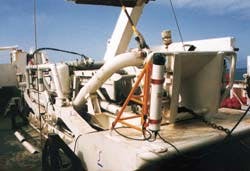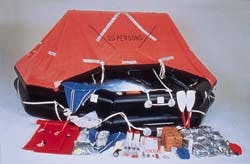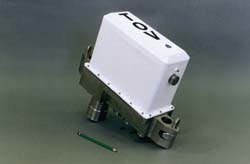FRANCE Surface - sea bottom data link shuts out noise interference
The Elise 3 plough with ORCA's MATS modem on the starboard bow.
Deepwater subsea developments are demanding installation of increasingly autonomous seabed structures. This trend was the basis for a new generation of underwater acoustic products from Brest-based ORCA Instrumen-tation. The latest of these, called MATS, is being offered as a reliable and cost-effective alternative to use of underwater cables.
MATS (multimodulation acoustic transmission system) is a two-way modem link for data exchange between the surface and sea bottom or between two subsea points. The challenge was to produce a system which works in severe environments, in terms of noise or obstacles.
MATS provides three different modulations and data rates which can be varied from 20-4,800bit/s. These can programmed in real time, over the acoustic link, to optimize each application. Data coding is also implemented to increase overall reliability of the link.
Offshore applications can include:
- Retrieving data of sea-bottom reservoir loggers from a central platform. This can be done at 20bit/s (with zero error) over a range of a few kilometers (i.e. a horizontal link with numerous multipaths and acoustic interference).
- Real-time monitoring of anchor line tension from a supply boat. This task requires good protection against surrounding noises such as the drilling platform, engines and propellers. A 150bit/s baud rate transmission will secure perfect data reception, according to ORCA.
- A bilateral link between a pipelay vessel and its plough: commands are transmitted to the towed vehicle which in return sends data to the surface vessel. This avoids the high cost of an electromechanical cable, often several kilometers long, which also has to be replaced frequently. In tests with the France Telecom cable-laying vessel Vercors and the Elise 3 plough, good results were recorded consistently, in water depths from 50-1,000 meters, with data baud rates from 20-1,200bit/s.
Thermobonding helps Zodiac rafts withstand humidity
Zodiac throw-over liferaft.
Throw-over liferafts from Zodiac are claimed to be the most recent of this genre to be approved to SOLAS standards. Following trials witnessed by the major maritime administrations, they have been deemed suitable for drops from a height of at least 36 meters, carrying up to 50 passengers.
Like all Zodiac's liferafts, the throw-over range are made with a durable polyurethane-coated fabric, and assembled using Zodiac's hot assembly technique, called thermobonding.
Components of other manufacturers' rafts are still glued together, making them prone to come apart in humid, hot conditions. Thermobonding, however, is a computer-controlled technique which involves welding strips of a special fiber together. The result, Zodiac claims, is airtight and extremely resistant to the effects of humidity. The fabric's weight and structure also makes the throw-over rafts easy to service.
A unique, built-in cellular foam floor provides enhanced protection against hypothermia and increased comfort. It is coated with a resistant layer of aluminum film, retaining and throwing back body heat to protect survivors from the cold of the water.
Other rafts have featured inflatable floors to insulate against the cold, but this can be punctured. Zodiac's floor is lighter and is not inflatable, so there is no chance that it will not work when the raft is launched.
The double-insulated canopy is fitted with ventilation and observation portholes, a rainwater collector and large, easy to close doors successfully tested using immersion gloves. With its strong, inflatable supporting arch it can withstand gale force winds and extreme sea conditions. An outside signaling light and inside comfort light activate automatically when the canopy is being erected.
Zodiac makes a wide range of liferafts: it is the sole supplier of rafts to Elf operations in West Africa. It has a growing service station network worldwide, including a newly opened operation in Vung Tau, Vietnam.
TOV enhances xmas tree valve operations in deep waters
ECA's TOV module
TOV panel and installation tool.
Toulon-based ECA has introduced what it claims is a new concept in subsea control systems: an electrohydraulic network of tele-operated valve (TOV) modules. The system is said to be cheaper and more reliable than conventional pod-based systems, and better adapted to deepwater fields.
Innovation comes from the fact that the umbilical, connected to the xmas tree, acts as the support to the electrohydraulic network, linking the TOV modules to the surface unit. Every xmas tree valve is equipped with a TOV module, which has the capability to control this valve and to acquire two-sensor data.
For xmas tree interface simplification purposes, and to maximize the number of fixed connections as opposed to wet connections, the TOV modules are plugged into a panel which is part of the xmas tree structure. Installation/retrieval tools have been manufactured for diver and ROV operations. The light weight of both the module (930kg) and the tool (50kg) allow easy intervention by ROV down to 2,000 meters.
The TOV's compactness, light weight and reliability (one million hours MTBF, according to ECA) have been achieved partly through use of aeronautical technology for the electronic part. The electronics are contained entirely in a sole, hybrid circuit measuring 64 x 64mm which manages the network communications, controls the valve, acquires external and internal sensor data and processes a few of them.
The TOV system is fully developed, and a long-term underwater demonstration is due to start by the end of this year in Norway in partnership with several oil companies interested in the concept: Statoil, BP, Norsk Hydro, Elf, and Total. The demonstration will also include qualification of a subsea HPU using water-based fluid.
Copyright 1995 Offshore. All Rights Reserved.



